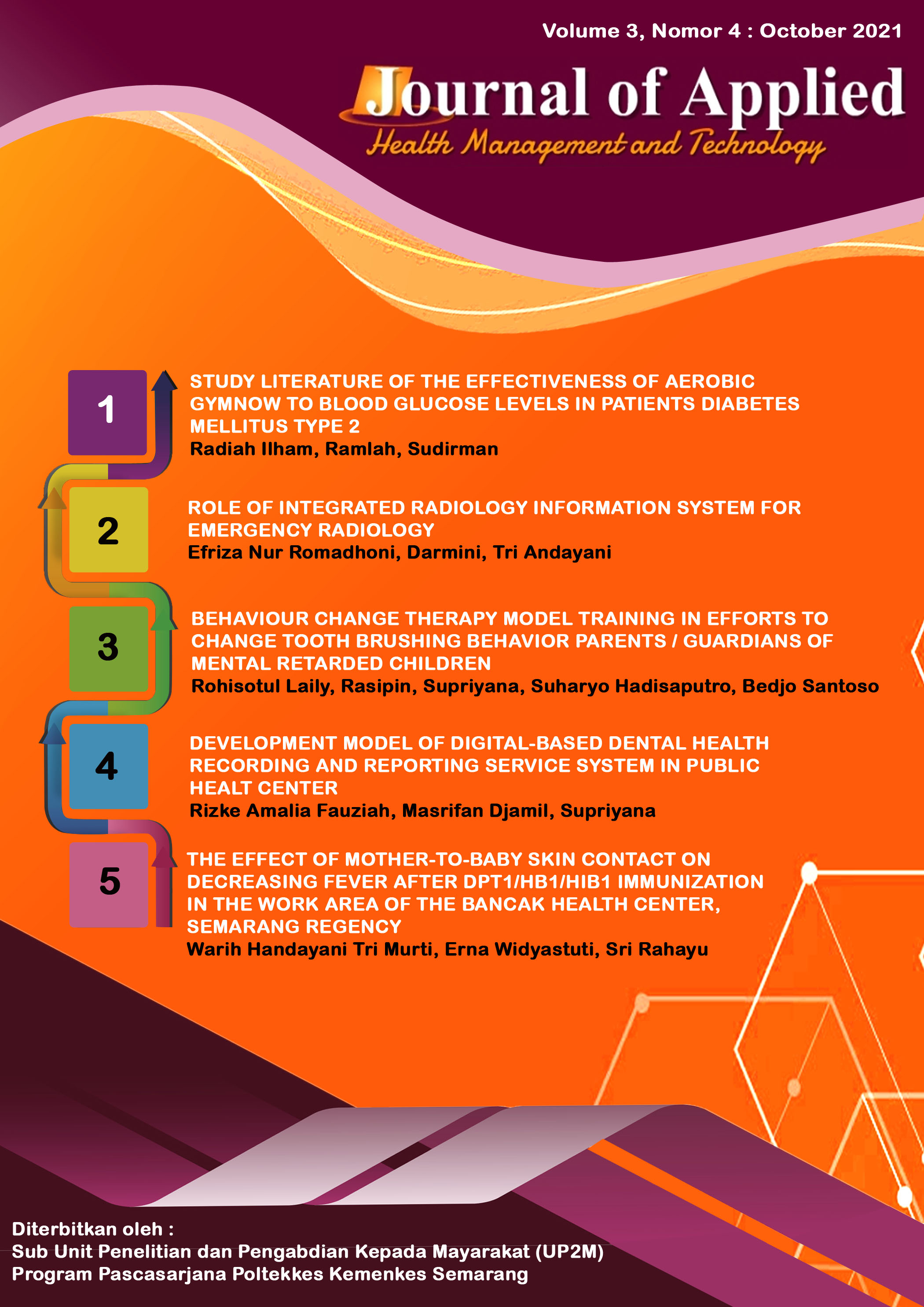Digital Image Collection Techniques From Pacs To Make A Deep Learning Application For Cardiomegali Detection
DOI:
https://doi.org/10.31983/jahmt.v5i1.9485Keywords:
PACS, Deep Learning, Cardiomegaly, ClassificationAbstract
Picture archiving and communication system (PACS) in digital images functions as a system which can retrieve, archive, display and process digital images. PACS management is well supported by with digital modalities, the number of examinations continues to increase, there is a potential for the availability of large digital image data (big data). The availability of big data radiological images opens up opportunities for development Artificial intelligence (AI) with deep learning method. An example of using deep learning in radiology is the automatic detection of the size of the heart, whether it is classified as cardiomegaly or whether the heart is normal from a thoracic image. Before making a deep learning application, it is necessary to know how PACS works where we retrieve data, how the process of retrieval and classification of thoracic image data from PACS. This paper is sourced from the literature review and the results of observations following clinical practice at Dr. Cipto Mangunkusumo Hospital. From observations in clinical practice, PACS has functioned as a place to archive, display, print and send radiology digital images. Digital image data collection from PACS, through the process of data classification, tabulation, identification, image retrieval and data grouping, is the first step for making deep learning programs. The conclusion that can be drawn is thatPACS is a large source of digital image data, good data retrieval and initial data classification techniques will facilitate and improve the performance of deep learning creation.
Picture archiving and communication system (PACS) pada gambar digital berfungsi sebagai sistem yang dapat mengambil, mengarsipkan, menampilkan dan mengolah gambar digital. Manajemen PACS didukung dengan baik dengan modalitas digital, jumlah pemeriksaan terus meningkat, ada potensi ketersediaan data citra digital (big data) yang besar. Ketersediaan citra radiologi big data membuka peluang pengembangan Artificial intelligence (AI) dengan metode deep learning. Contoh penggunaan deep learning dalam radiologi adalah deteksi otomatis ukuran jantung, apakah itu diklasifikasikan sebagai kardiomegali atau apakah jantung normal dari gambar toraks. Sebelum membuat aplikasi deep learning, perlu diketahui cara kerja PACS dimana kita mengambil data, bagaimana proses pengambilan dan klasifikasi data citra toraks dari PACS. Tulisan ini bersumber dari kajian pustaka dan hasil observasi pasca praktik klinis di RSUD Dr. Cipto Mangunkusumo. Dari pengamatan dalam praktik klinis, PACS telah berfungsi sebagai tempat untuk mengarsipkan, menampilkan, mencetak dan mengirim gambar digital radiologi. Pengumpulan data citra digital dari PACS, melalui proses klasifikasi data, tabulasi, identifikasi, pengambilan citra dan pengelompokan data, merupakan langkah awal pembuatan program deep learning. Kesimpulan yang dapat ditarik adalah bahwa PACS merupakan sumber data citra digital yang besar, teknik pengambilan data yang baik dan klasifikasi data awal akan memudahkan dan meningkatkan kinerja penciptaan deep learning
References
Clinic M. Enlarged heart. 2020.
Whitley AS, Jefferson G, Holmes K, Sloane C, Anderson C, Hoadly G. Clark’s positioning in radiography. 13th edn. Vol. 146, Medical Journal of Australia. 2016.
Rao BV raghawa. Clinical Examination in Cardiology. 2007. 26–26 p.
Li Z, Hou Z, Chen C, Hao Z, An Y, Liang S, et al. Automatic Cardiothoracic Ratio Calculation with Deep Learning. IEEE Access. 2019;7:37749–56.
Alghamdi SS, Abdelaziz I, Albadri M, Alyanbaawi S, Aljondi R, Tajaldeen A. Study of cardiomegaly using chest x-ray. J Radiat Res Appl Sci. 2020;13(1):460–7.
Candemir S, Jaeger S, Lin W, Xue Z, Antani S, Thoma G. Automatic heart localization and radiographic index computation in chest x-rays. Med Imaging 2016 Comput Diagnosis. 2016;9785:978517.
Fukuyama. Mayumi. Society 5.0: Aiming for a New Human-centered Society. Japan SPOTLIGHT. 2018;(August):8–13.
Euclid Seeram. Digital radiography Physical Principles. Feline Diagnostic Imaging. 2019. 3–11 p.
Quinn B.Carroll, M.Ed. R. Digital Radiography in Practice. 2019.
Korner M, Weber CH, Pfeifer SWKF, Treitl MFRM. Advances in Digital Radiography : Physical Principles and System Overview. 2007;
Aldosari H, Saddik B, Al Kadi K. Impact of picture archiving and communication system (PACS) on radiology staff. Informatics Med Unlocked. 2018;10(November 2017):1–16.
Talati IA, Choi HH, Filice RW. Cinebot: Creation of Movies and Animated GIFs Directly from PACS—Efficiency in Presentation and Education. J Digit Imaging. 2020;33(3):792–6.
Chamveha I, Promwiset T, Tongdee T, Saiviroonporn P, Chaisangmongkon W. Automated Cardiothoracic Ratio Calculation and Cardiomegaly Detection using Deep Learning Approach. 2020;1–11.
Lee MS, Kim YS, Kim M, Usman M, Byon SS, Kim SH, et al. Evaluation of the feasibility of explainable computer-aided detection of cardiomegaly on chest radiographs using deep learning. Sci Rep. 2021;11(1):1–11.
Abadi M, Agarwal A, Barham P, Brevdo E, Chen Z, Citro C, et al. TensorFlow: Large-Scale Machine Learning on Heterogeneous Distributed Systems. 2016;
Erickson BJ, Korfiatis P, Akkus Z, Kline TL. Machine learning for medical imaging. Radiographics. 2017;37(2):505–15.
Çallı E, Sogancioglu E, van Ginneken B, van Leeuwen KG, Murphy K. Deep learning for chest X-ray analysis: A survey. Med Image Anal. 2021;72.
Ma W, Sartipi K. An agent-based infrastructure for secure medical imaging system integration. Proc - IEEE Symp Comput Med Syst. 2014;(May 2014):72–7.
Duan Y, Edwards JS, Dwivedi YK. Artificial intelligence for decision making in the era of Big Data – evolution, challenges and research agenda. Int J Inf Manage. 2019;48(January):63–71.
Trebeschi S, Van Griethuysen JJM, Lambregts DMJ, Lahaye MJ, Parmer C, Bakers FCH, et al. Deep Learning for Fully-Automated Localization and Segmentation of Rectal Cancer on Multiparametric MR. Sci Rep. 2017;7(1):1–9.

